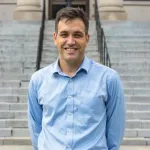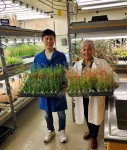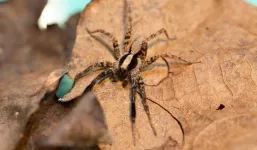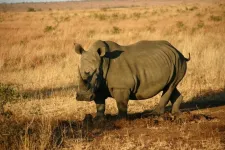(Press-News.org) After children experienced severe traumatic brain injury, the infusion of bone marrow mononuclear cells derived from the patient’s own bones led to less time spent in intensive care, less intense therapy, and, significantly, the structural preservation of white matter, which constitutes about half the total volume of the brain, according to new research from UTHealth Houston.
The study, published recently in the medical journal Brain, was based on the results of a Phase II clinical trial led by first author Charles S. Cox Jr., MD, the George and Cynthia Mitchell Distinguished Chair in Neurosciences and the Glassell Family Distinguished Chair in the Department of Pediatric Surgery with McGovern Medical School at UTHealth Houston, and senior author Linda Ewing-Cobbs, PhD, professor and the Harriet and Joe Foster Chair in Cognitive Neuroscience in the Department of Pediatrics at the medical school.
Overall, the authors found that autologous bone marrow nuclear cell infusion in children within 48 hours of severe traumatic brain injury was safe and feasible. “The structural preservation of white matter was our primary outcome in this study. It’s important because it was an objective, quantitative, physical measurement as opposed to a psychological test,” said Cox, who is also a faculty member with The University of Texas MD Anderson Cancer Center UTHealth Houston Graduate School of Biomedical Sciences. “Multiple studies by other researchers have shown that, over one to two years’ time, your brain loses up to 15% of its white matter after severe traumatic brain injury. That cerebral atrophy – which correlates strongly with negative outcomes – is what we’re interrupting with this new treatment.”
In previous studies, bone marrow nuclear cells derived from the same individual have shown some promise in treating traumatic brain injury. The research team evaluated the effectiveness of the treatment in children, particularly investigating whether the cells can preserve the blood-brain barrier and diminish neuroinflammation.
Forty-seven patients ages 5 to 17 with severe traumatic brain injury were randomized into a double-blind, placebo-controlled clinical trial at two children’s hospitals in Houston, Texas, and Phoenix, Arizona. Bone marrow harvest, cell isolation, and infusion were completed within 48 hours post-injury.
According to study results, the therapy also resulted in enhanced connectivity of the corpus callosum, a midline structure in the brain consisting of white matter tracts that connect the left and right cerebral hemispheres. The connectivity helps with associative thought, executive functioning, and other aspects of higher-order thinking.
“Our findings are very encouraging as very few biological interventions have shown significant clinical benefit in improving the course of patients with severe traumatic brain injury,” said Ewing-Cobbs, a neuropsychologist with the Children’s Learning Institute at UTHealth Houston. “Traumatic brain injury is a leading cause of death and acquired disability around the world. Our findings regarding clinical, neuroimaging, and functional outcomes give hope regarding the potential of cellular therapy to reduce chronic neurobehavioral problems and improve quality of life for children and adolescents.”
The researchers are now in the process of developing the design and approach of a pivotal Phase III clinical trial.
The study was funded by two National Institutes of Health grants (R01NS077963 and T32GM008792), as well as by the Glassell Family Foundation, the Mission Connect/TIRR Foundation, the Lloyd Bentsen Stroke Center Award, the Brown Foundation, the Nicole and Evan H. Katz Pediatric Neurodevelopmental Fund, and the Evelyn Griffin Stem Cell Research Laboratory.
Other study co-authors with McGovern Medical School at UTHealth Houston included Jenifer Juranek, PhD; Fabio Triolo, DdR, MPhil, PhD; Steven Kosmach, MN, RN; Sean I. Savitz, MD; Claudia Pedroza, PhD; Scott D. Olson, PhD; Michael C. Scott, MD; Henry W. Caplan, MD; Brijesh S. Gill, MD; and Robert A. Hetz, MD. Akshita Kumar, MD; Benjamin M. Aertker, MD; and Margaret L. Jackson, MD, all formerly with UTHealth Houston, are now with the University of Tennessee; HCA Houston Healthcare Clear Lake and Harris Health Ben Taub General and Lyndon B. Johnson Hospitals; and Houston Methodist Hospital, respectively.
Co-authors with Phoenix Children’s Hospital included David M. Notrica, MD; Jeffrey H. Miller, MD; P. David Adelson, MD; and Michael S. Lavoie, PhD.
END
Infusion of bone marrow mononuclear cells results in decreased intensive care needs and white matter preservation for children with severe traumatic brain injury
2024-01-18
ELSE PRESS RELEASES FROM THIS DATE:
National award goes to Sandia Labs engineer
2024-01-18
ALBUQUERQUE, N.M. — Tony Garcia often reflects on his grandfather’s words: “Work hard and be good to people, and you’ll end up happy.”
This simple principle has been Garcia’s beacon throughout his academic and professional journeys, and now has led to his recognition with a prestigious 2023 Society of Hispanic Professional Engineers STAR of Today award for technical achievement.
The STAR awards recognize individuals in STEM who are not only excelling in their fields but also making a significant impact through their work, research ...
Researchers make links between woolly mammoths and colonization of the Americas
2024-01-17
Imagine journeying back in time to the era of woolly mammoths, some 14,000 years ago. That’s what a team of international researchers from the University of Ottawa, the University of Alaska Fairbanks, McMaster University and Adelphi University, and Indigenous scholars, managed to do. Using novel high-resolution isotope profiling (a sort of “paleo-GPS”), they were able to connect the dots between the wanderings of a woolly mammoth and the earliest known human settlements in the remote ...
Governor Hochul announces CUNY to receive $75 million from the Simons Foundation, largest donation in university history
2024-01-17
Governor Kathy Hochul today announced that the City University of New York is receiving $75 million from the Simons Foundation, the University’s largest-ever donation. The gift earmarks $50 million to establish CUNY as a hub for computational science and $25 million to support CUNY’s participation in the Governor’s proposed Empire AI project. Computational science uses programming techniques to solve problems in fields such as biology, astrophysics and neuroscience.
“For many New Yorkers, higher education is critical to pursuing a career ...
Keys to aging hidden in the leaves
2024-01-17
Scientists have known about a particular organelle in plant cells for over a century. However, UC Riverside scientists have only now discovered that organelle’s key role in aging.
The researchers initially set out to understand more generally which parts of plant cells control plant responses to stress from things like infections, too much salt, or too little light. Serendipitously, they found this organelle, and a protein responsible for maintaining the organelle, control whether plants survive being left too often in the dark.
Because they had not expected this discovery, which is ...
Rain can spoil a wolf spider’s day, too
2024-01-17
If you hate the rain, you have something in common with wolf spiders.
Researchers at the University of Cincinnati found that wolf spiders can’t signal others or perceive danger from predators as easily on rain-soaked leaves compared to dry ones. Even communicating with would-be mates is harder after it rains.
The study was published in the Journal of Insect Behavior.
Biologists in UC’s College of Arts and Sciences studied Schizocosa ocreata, a wolf spider found across much of the United States. Males respond to chemical signals from females by using a combination of visual ...
Independent dispute resolution of no surprises act financially unviable for radiology
2024-01-17
Leesburg, VA, January 17, 2024—According to the American Journal of Roentgenology (AJR), the No Surprises Act’s (NSA) independent dispute resolution (IDR) process would be financially unfeasible for a large portion of out-of-network (OON) claims for hospital-based specialties—more so for radiologists than other specialists.
“Although the NSA enacted important patient protections, IDR fees limit clinicians’ opportunities to dispute payer-determined payments and potentially undermine their bargaining power in contract negotiations,” ...
AMS presidential forum to address “Climate Science as Service to Society”
2024-01-17
[Boston, MA—January 17, 2024] The American Meteorological Society (AMS) will open its 104th Annual Meeting with a Presidential Forum on how to advance society’s acceptance and use of climate science. Distinguished atmospheric scientist Dr. Kerry Emanuel will moderate a “fireside chat” with Monica Medina, President and CEO of the Wildlife Conservation Society and former Deputy Assistant Secretary at the State Department, and Bob Inglis, Executive Director of RepublicEn.org and former congressman from South Carolina. The Forum, with opening remarks by AMS President ...
Researchers find anti-HIV drugs may prevent complications from bacterial sepsis
2024-01-17
Bacterial infections can lead to the formation of abscesses — pockets of dead cells and debris surrounded by inflammatory immune cells. Bacteria multiply within abscesses, causing more inflammation and further damage to surrounding tissues. In severe cases, these immune reactions spread across the body, resulting in life-threatening organ failure, or sepsis. But how these abscesses form and what can be done to prevent them were previously not well understood.
Using preclinical models, investigators from Brigham and ...
The heat is on: UMass Amherst scientists discover southern Africa’s temps will rise past the rhinos’ tolerance
2024-01-17
January 17, 2024
The Heat is on: UMass Amherst Scientists Discover Southern Africa’s Temps Will Rise Past the Rhinos’ Tolerance
New research shows that rising temperatures caused by climate change are impacting the remaining black and white rhinoceros populations on the African continent, suggests taking steps to mitigate impact now
AMHERST, Mass. – Southern Africa contains the vast majority of the world’s remaining populations of both black and white rhinoceroses ...
Next generation spinal fusion goes "meta"
2024-01-17
A civil engineer at the University of Pittsburgh is applying his expertise in bridges and infrastructure to develop new materials that better treat spinal injury, repair, and recovery. Amir Alavi’s proposal received a $557,000 boost from the National Institutes of Health to test the first “metamaterial” orthopedic implants.
With an estimated 342,000 procedures per year in the U.S.1, interbody spinal fusion is a popular procedure to treat a range of spinal pain and injuries, from herniated discs and degenerative diseases to trauma. Interbody fusion cages are spinal implants that are used in most of ...





